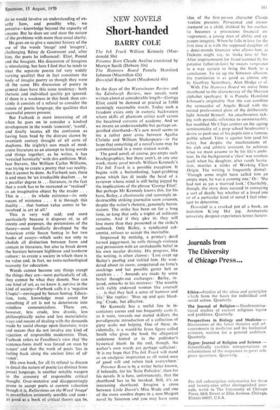Dual control
Martin SEYMOIJR-SMITH
Reflections on the Word 'Image' P. N. Furbank (Macmillan 63s)
P. N. Furbank has written a thoughtful and pertinent series of reflections on the implica- tions of the manner in which intelligent readers think—or, rather, it seems, that they at times fail to think—of the terms 'image' and 'imagery'. His opening argument is that there is something inherently puzzling in the fact that literary criticism in general tends to use the terms 'imagery' and 'metaphor' (and 'simile') as more or less synonymous. Furbank is right. indeed, when he asserts that 'a doubt flits across' our minds when we use the term 'imagery'—what do we think we mean?—and he is right, too, to trace it to our tendency to use it synonymously with 'metaphor': for this does obscure the com- paring element in metaphor.
An image. Furbank points out, cannot have the richness of metaphor: 'there is no one right way of "realising" a metaphor: there are a hundred ways, and the mind is set to work ranging among them'. We talk about a poet's 'imagery' when in fact the final result of our reading cannot be a picture at all: Furbank gives as an example Milton's 'A Forest huge of Spears', and comments that we cannot permanently picture something. even in the mind's eye, as both a forest and spears. Uccello. on the other hand. can 'present both spears and a forest in different bits of the same painting, thus presenting a visual analogy'. That is something rather simpler. As Furbank observes: 'Literature is always general, though with strong Yearnings towards the concrete . just as painting is always particular. though with strong yearn- ings towards the general'. We can to a cer- tain extent be deceived by painting; but no one 'ever mistook a page of Wordsworth's Poems for an old Cumberland beggar' Furbank does not of course solve the pro- blems that arise from the confusion to which he has so fruitfully drawn our attention. To do so would involve an understanding of ex- actly how, and possibly why, we perceive—knowledge beyond the capacity of anyone. But he does see and state the nature of the problems with more than usual clarity.
He goes on to give a succinct history of the use of the words 'image' and 'imagery', challenging Remy de Gourmont and, after him, the poets he influenced : Eliot, Pound and the Imagists. His discussion of Imagism is stimulating, but here I find that he tends to treat the separate poems (of very widely
varying quality) that in fact constitute the body of imagist poetry as though they were all the same. His discussion of poetry in general does have this same tendency : both rhetoric and individual quality get ignored. If there is a weakness in this book then cer- tainly it consists of a refusal to consider the nature of poetic language, the qualities that successful poems possess.
But Furbank is most interesting of all when he goes on to consider a kindred development in the words 'concrete', 'world', and finally locates all the confusion as having been bred by the distrust shown by twentieth century thought of all sorts of dualisms. He (rightly) sees much of mod- ernist literature as an attempt to bring words and things together; as he writes, it has 'wrestled heroically' with this ambition. Wal- lace Stevens, like William Carlos Williams, was trying to create a poetry that was reality. But it cannot be done. As Furbank sees, there
is and must be 'an irreducible dualism to a peculiar degree in ... literature, in the fact that a work has to be recreated or "realised" as an imaginative object by the reader . . . This is . . . its whole existence—its only means of existence . . . it is through this duality.., that human value comes to be- involved in art at all.'
This is very well said; and most particularly because it disposes of, to all intents and purposes, the pretensions of the theory—most familiarly developed by the American critic Susan Sontag in her two books of essays—which seeks not only to abolish all distinction between form and content in literature, but also to break down the barriers between highbrow and lowbrow culture: to create a society in which there is no value and, in fact, no extra-technological necessity for education.
Words cannot become any things except the things they are—most particularly of all, they cannot be what they denote. Nor can any kind of art, as we know it, survive in the kind of society—Furbank calls it a 'negative Utopia'—envisaged by Susan Sontag. Educa- tion, taste, knowledge must count for something if art is not to deteriorate into mindless commercialism. There are, however, less crude, less drastic, less philosophically naive and less materialistic ways and means of dealing with the demands made by social change upon literature, ways and means that do not involve any kind of rejection of responsible modernism. Thus, Furbank refers to Fenollosa's view that 'the sentence-form itself was forced on man by nature' and that the work of poets 'lies in feeling back along the ancient lines of ad- vance'.
His own book, for all its refusal to discuss in detail the nature of poetic (as distinct from prose) language, is another notable weapon in the armoury of responsible critical thought. Over-tentative and disappointingly
prone to accept poets at current valuation though it is, Reflections on the Word 'Image' is nevertheless eminently sensible and sane: as good as a book of critical theory can be.































 Previous page
Previous page